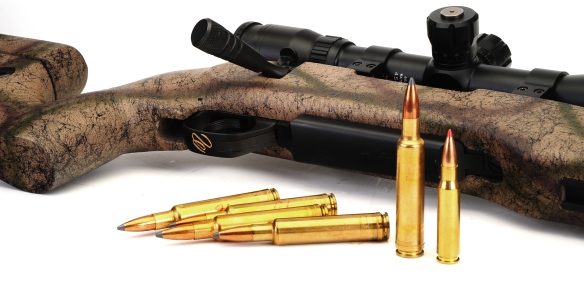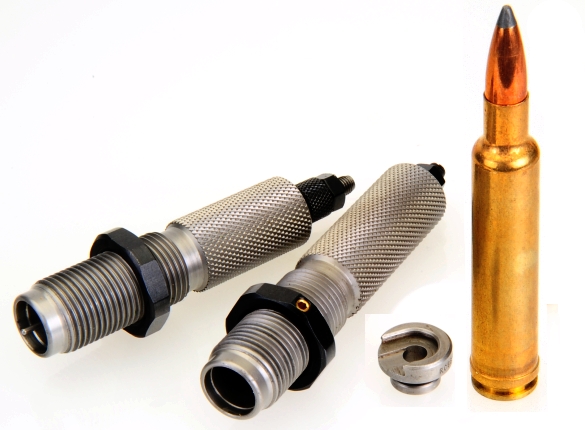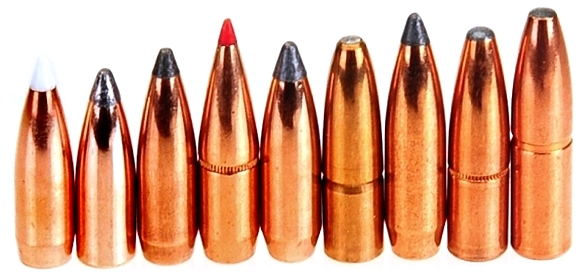
After spending some time with the big Mark V TRR RC Weatherby, I can honestly say that this is the type of rifle that would see a lot of use; range time, tactical applications or pressed into service for extreme range hunting. It’s always fun to shoot a rifle that can hit something very small at a very long distance. Sure, it’s loud and it kicks, as anyone shooting a rifle chambered for the 338-378 Weatherby Magnum might expect, but that is as much a part of this rifle’s personality as is hitting dinner plate size targets at 1,000 yards.
| Indices | Range 0 -1000 yards 250 Grain Sierra MatchKing | ||||||||||
| Range -yds | 0 | 100 | 200 | 300 | 400 | 500 | 600 | 700 | 800 | 900 | 1000 |
| Velocity – ft./sec. | 3100 | 2934 | 2774 | 2619 | 2470 | 2326 | 2186 | 2052 | 1923 | 1800 | 1680 |
| Energy – ft.-lbs. | 5334 | 4779 | 4272 | 3808 | 3385 | 3001 | 2653 | 2338 | 2053 | 1797 | 1567 |
| Path – in. | -1.5 | 24.4 | 46.3 | 63.7 | 76.0 | 82.6 | 82.8 | 75.7 | 60.3 | 35.5 | 0.0 |
Closer in, at three football fields distance, the 338-378 Weatherby is a point blank cartridge, with an ordinate never greater than 3″ above or 3″ below line of sight over that entire range and terminating with nearly two tons of kinetic energy.
|
338-378 Weatherby |
Range 0 -300 yards 250 Grain GameKing | ||||||
| Range -yds | 0 | 50 | 100 | 150 | 200 | 250 | 300 |
| Velocity – ft./sec. | 3100 | 3013 | 2928 | 2844 | 2762 | 2681 | 2602 |
| Energy – ft.-lbs. | 5334 | 5040 | 4759 | 4490 | 4234 | 3990 | 3757 |
| Path – in. | -1.5 | 1.0 | 2.5 | 3.0 | 2.4 | 0.7 | -2.2 |
The 338-378 Weatherby, at 137 grains, is the king of capacity in this caliber. Other cartridges utilized in similar applications are the 338 Winchester Magnum, 340 Weatherby, 338 Remington Ultra Mag, and the 338 Lapua with grains capacities of: 86, 100, 110, and 108 respectively. A couple of decades ago, limited very slow burning powder selection limited the potential of the biggest case, but that is a thing of the past. At 300 yards, the 338-378 Weatherby Magnum is within 50 fps of the 338 Winchester Magnum’s muzzle velocity and energy.
The 338-378 Weatherby Magnum is an excellent handloader’s cartridge for a few reasons. The first is that there is a substantial selection of bullets available in this caliber, both hunting and match, that are not available in factory ammunition form. The second reason is that the cartridge is flexible and tunable for accuracy; start with a 250 grain bullet that won’t group under 2 MOA, play with seating depth, powder and charge weights and you end up with a sub MOA performer. The third is the high cost of factory ammunition that is typical for these big rounds.
If you’re driving ZR1 Corvette, don’t gripe about the price of gas…
You might say that if you can afford the $4,100 rifle, you should be able to afford the ammo. However, the chamber is also available in the $2,700 Mark V TRR Custom Magnum and in the comparatively budget priced $1,900 Accumark. Factory ammunition prices for the .338-378 Weatherby Magnum range from $138 to $162 from the two primary sources, Weatherby and Nosler. As a percentage of the total cost of a big and dangerous game hunt, that expense is probably insignificant, but for proficiency training and casual recreational shooting, the cost is notable, AKA a $400 day at the range. Fortunately, there is the option of handloading. Tell me more, Joe. Sure…
We’ve been handloading the 338-378 Weatherby Magnum in the shop since 1998. If there is anything that stands out regarding this activity it is that tools and support equipment for this oversize cartridge are no more costly than handloading the 30-06 Springfield or 308 Winchester. Two die resizer and seater die sets: RCBS $28, Hornady $68 and Redding $80, Any reloading press or lathe type trimmer that can handle the 375 H&H can handle the 338-378 Weatherby. Inertial bullet pullers generally are not large enough to accommodate the case, but collet pullers work well.

Brass requires tending. Usually Norma brand, the same folks who make the Weatherby head stamped brass, can be found on sale in the $40/20 to $45/20 price range. Off sale, or Weatherby brand, typically is priced at $80/20 to $85/20. I can usually get ten loads out of a case if I anneal the neck and shoulders every other reload, which means 20¢ to 40¢ in cost per case for handloaded ammunition, dependent upon source. Cases will not last long without annealing. Without annealing, the cases work harden and start to ring like a bell when tapped after a couple of reloading cycles and case necks may begin to split after three cycles.
When Real Guns began reloading the 338-378 Weatherby Magnum, powder selection was initially IMR 7828, H1000, RL 22, and H870, however H1000 and H870 eventually fell away, replaced by MagPro, RL 25, RL 50 and RS Magnum. All are a bit too fast, or a bit too slow. RL 33 should be a good pick when it is readily available. Vihtavuori N165 is too fast, N170 is just right, but unavailable and both are way overpriced at $32/Lb. Typical handloads cost less than $20 per box with good bullets, $30 with exceptional hunting bullets +$10 added to both if brass can’t be found on sale.
The Barrel Burner Index for the 338-378 Weatherby is 25.5, making it just slightly less overbore than the 30-378 Weatherby Magnum. Subsequently, powder selection requires some strategy, as does establishing a workable cartridge overall length to achieve best accuracy and proper pressure levels. Sometimes seating bullets more deeply reduces net case capacity and improves accuracy, but charges must be reduced accordingly. Sometimes bullets can be seated out to accommodate slightly slower powder and to move the bullet closer to the barrel’s leade if these are of consequence. Sometimes very slow powder is not effective with light bullets and results can be disappointing.
I knew a guy nicknamed Bullet Head… Or was it Bucket Head?
Part 1 of Weatherby’s Mark V® TRR RC wrapped up with a few 200 yard groups shot that looked a lot like 200 grain @ 3,395 fps 1 1/2″ at 200 yards, 215 grain @ 3,201 fps under 1 3/4″ and a 250 grain @ 3,069 fps that shot just a tad over 1″. Below, the final selection isn’t an endorsement of any, they are meant to be representative of weights and construction types useful mostly to hunters. The 180 grain is light. Nosler indicates a minimum impact velocity of 1,800 fps for proper expansion and “unlimited” for maximum. Now there’s a challenge…

 Components are easy to come by as 0.338″ cartridges are quite popular. 0.338″ mid to heavyweight bullets have an exceptional sectional density and ballistic coefficient so, if you can launch them, they will keep on going over a very long distance. Bullets appearing on the table below are in the order, left to right, that they appear in the picture above.
Components are easy to come by as 0.338″ cartridges are quite popular. 0.338″ mid to heavyweight bullets have an exceptional sectional density and ballistic coefficient so, if you can launch them, they will keep on going over a very long distance. Bullets appearing on the table below are in the order, left to right, that they appear in the picture above.
Warning: Bullet selections are specific, and loads are not valid with substitutions of different bullets of the same weight. Variations in bullet length will alter net case capacity, pressure and velocity. Primer selection is specific and primer types are not interchangeable. These are maximum loads in my firearms and may easily be excessive in others. All loads should be reduced by 5%, and developed following safe handloading practices as represented in established reloading manuals produced by component manufacturers. Presentation of these loads does not constitute a solicitation for their use, nor a recommendation.
|
Cartridge: 338-378 Weatherby Magnum |
|
| |
|
| |
|
| |
|
| |
|
| Bullet Type | Bullet Weight | Net Water Capacity | COL | Powder Type | Powder Charge | Muzzle Velocity | Muzzle Energy |
200 Yard Group Size 3 Shot “ |
|
| Nosler AccuBond | 180 | 125.6 | 3.620 | AA MagPro | 120.0 | 3532 | 4985 | 2.1 | |
| Nosler AccuBond | 180 | 125.6 | 3.620 | RL 25 | 119.0 | 3526 | 4969 | 1.9 | |
| Nosler AccuBond | 180 | 125.6 | 3.620 | H1000 | 121.0 | 3476 | 4828 | 1.9 | |
| Speer SP | 200 | 128.9 | 3.700 | Retumbo | 126.0 | 3389 | 5100 | 1.7 | |
| Speer SP | 200 | 128.9 | 3.700 | IMR 7828 | 113.0 | 3361 | 5015 | 1.5 | |
| Speer SP | 200 | 128.9 | 3.700 | RS Magnum | 123.0 | 3393 | 5112 | 2.0 | |
| Sierra SP | 215 | 125.4 | 3.640 | AA MagPro | 115.0 | 3221 | 4952 | 1.9 | |
| Sierra SP | 215 | 125.4 | 3.640 | RL 25 | 114.0 | 3269 | 5102 | 1.6 | |
| Sierra SP | 215 | 125.4 | 3.640 | Retumbo | 122.0 | 3295 | 5182 | 1.7 | |
| Hornady SST | 225 | 124.2 | 3.760 | AA MagPro | 113.0 | 3239 | 5240 | 2.1 | |
| Hornady SST | 225 | 124.2 | 3.760 | RL 25 | 111.0 | 3175 | 5037 | 1.6 | |
| Hornady SST | 225 | 124.2 | 3.760 | IMR 7828 | 108.0 | 3213 | 5156 | 1.7 | |
| Speer SPBT | 225 | 125.9 | 3.680 | AA MagPro | 114.0 | 3182 | 5057 | 2.0 | |
| Speer SPBT | 225 | 125.9 | 3.680 | RL 25 | 112.0 | 3142 | 4933 | 1.7 | |
| Speer SPBT | 225 | 125.9 | 3.680 | H1000 | 115.0 | 3170 | 5022 | 1.5 | |
| Woodleigh PP | 250 | 126.2 | 3.725 | RL 25 | 110.0 | 3057 | 5189 | 1.8 | |
| Woodleigh PP | 250 | 126.2 | 3.725 | H1000 | 113.0 | 3105 | 5353 | 2.1 | |
| Woodleigh PP | 250 | 126.2 | 3.725 | IMR 7828 | 107.0 | 3090 | 5302 | 2.0 | |
| Sierra BTSP | 250 | 123.8 | 3.725 | Retumbo | 117.0 | 3102 | 5343 | 1.5 | |
| Sierra BTSP | 250 | 123.8 | 3.725 | H870 | 123.0 | 3080 | 5265 | 1.8 | |
| Sierra BTSP | 250 | 123.8 | 3.725 | IMR 7828 | 105.0 | 3026 | 5084 | 1.5 | |
| Speer Grand Slam | 250 | 125.6 | 3.725 | RL 25 | 109.0 | 3047 | 5153 | 2.0 | |
| Speer Grand Slam | 250 | 125.6 | 3.725 | Retumbo | 118.0 | 3107 | 5358 | 1.7 | |
| Speer Grand Slam | 250 | 125.6 | 3.725 | IMR 7828 | 106.0 | 3028 | 5090 | 1.7 | |
| Swift A Frame | 275 | 121.4 | 3.660 | RL 25 | 103.0 | 2890 | 5099 | 1.8 | |
| Swift A Frame | 275 | 121.4 | 3.660 | H1000 | 107.0 | 2903 | 5145 | 2.0 | |
| Swift A Frame | 275 | 121.4 | 3.660 | Retumbo | 111.0 | 2925 | 5225 | 1.9 |
In the end…
Starting with over a dozen years of accumulated load data for the 338-378 Weatherby Magnum it was easy to get decent group sizes out of the Weatherby Mark V TRR RC. A little tweaking here or there; I found the TRR RC more comfortable to shoot than the Accumark. The Bushnell’s Elite 6500 4.5-30 x 50mm with Warne rings and bases held up fine throughout the range sessions.

The Weatherby was shot from a sled with ten pounds of ballast and enough time was taken between shots to keep barrel temp down to very warm to the touch… which meant about three groups of three shots before pushing cool ambient air down the bore with a shop made cool box for fifteen or twenty minutes. The stock adjustment was fine the way it was received, comb, pull and cant. Shooting from the standing position with assistance from a good sling also yielded good results. Based on the changes to group size that came with minor adjustments to handloads, I realize there is a lot left in the TRR’s potential with more refined ammunition and a shooter of greater skill behind the scope. For more details on the TRR RC and other Threat Response products, stop by the Weatherby site.

Email Notification